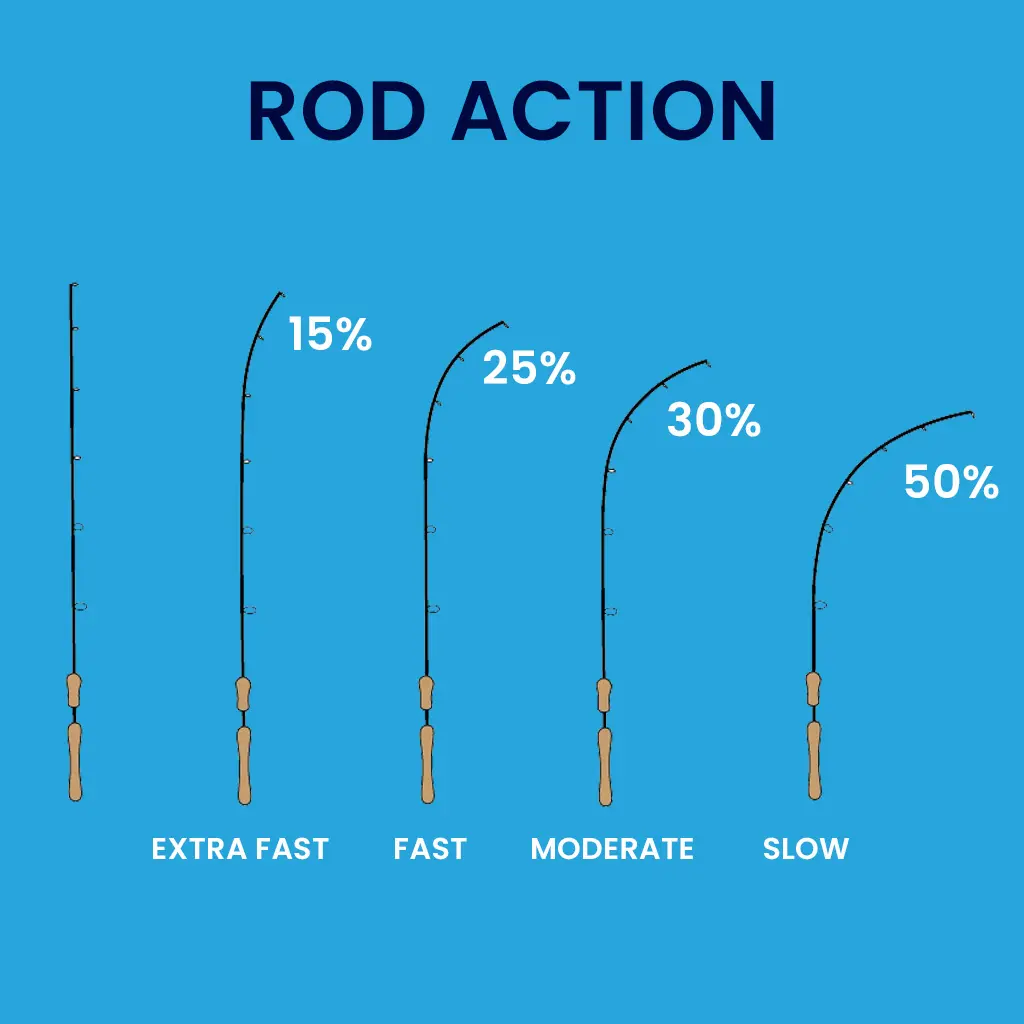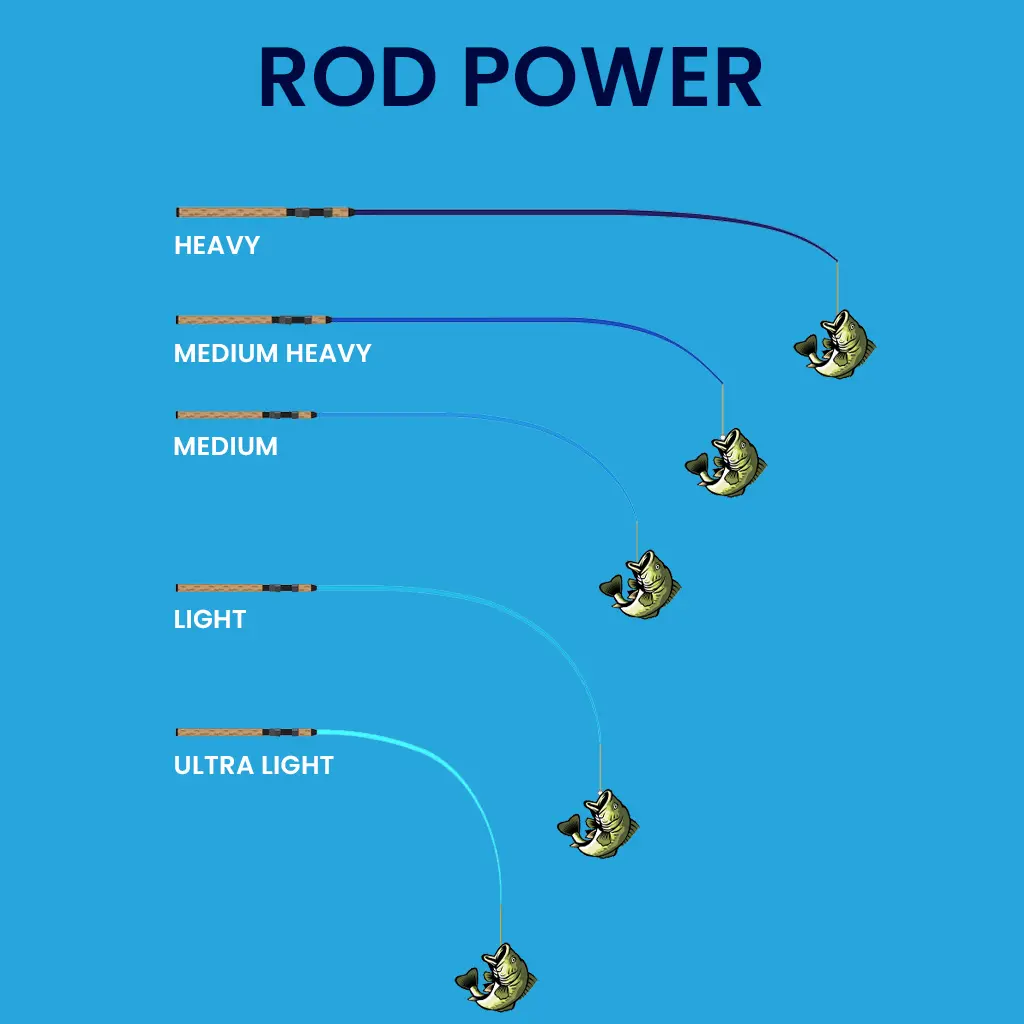You have all the essential equipment for fishing but still not working well in water. Why? To know the answer, 1st, you need to understand the factors that help you catch the Fish besides your fishing skills. Have you ever heard about the fishing rod power chart? Anglers of beginner level don’t know about it, while others need clarification about the difference between fishing rod power and action. They think both are the same term but not in reality. Both the terms, individually, play a vital role in water. Anglers should know about the difference between the two but also keep in mind that fishing rod power and action and their different kinds help to catch specific species of Fish.
Fishing rod action explanation

What does rod action mean? The 1st thing that anglers need to understand is action and power are two different terms. Rod action directs to the bend of the fishing rod when pressure is used. (i.e., when Fish bites the lures), while power, on the other hand, refers to the strength that resists the rod to flex.
These two aspects play a significant part in grabbing the specific kind of Fish.
The term ” fly rod action” means how the fly rod responds during casting, such as the percent of rod flex.
There are different types of fly rod action; Extra fast, fast, moderate, and slow:
Fast action rods bend 20 to 30% of the rod at the tip, while moderate action rods bend 30 to 40% by maintaining flexibility and sensitivity. However, slow-action rods flex nearly 50% of the rod.
Extra Fast action rod:
The extra-fast action rod is the stiffest, which means this rod has minimal flexibility and bends when pressure is applied. This fly-fishing rod bends at the top third portion of the tip, making it sensitive and suitable for more accurate and precise casting. Extra fast action fishing rod is widely used in windy conditions.
A fast-action fishing rod is a good option for specific angling scenarios and fishing techniques. Here are some situations where an extra-fast action rod is used for:
Power and distance casting
It is specifically designed for maximum power and quick rod recovery, making it best for casting long distances.
Suppose you want to target Fish in a larger water body or a type of Fish requiring a long cast. So, an extra-fast power action rod is suitable for you.
Windy conditions:
This rod is also suitable in windy conditions because of its high level of stiffness that maintains the line control.
Strong Fish and heavy covers
This rod is helpful when targeting powerful fish species and is the best extra-fast rod action for bass, salmon, or saltwater species. This rod provides extra strength to hold these Fish.
Additionally, the extra fast action rod is used in areas heavily covered with vegetation or weeds, requiring quick response to pull out the Fish, avoiding snagging.
Fast Rod action
Fast-action rods manage to bend near the tip of the rod, making the rod more sensitive and quicker to respond.
These rods are suitable for beginners because of their accuracy. Fast-action rods are used for accurate and short or long-distance casting where the fishing game is very large. The fast action rods are used for fishing areas covered with weeds to take the Fish’s skull up. The fast-action rod has a hard and powerful hook.
Largemouth bass, pike, and musky can be smoothly caught by using a fast action rod.
Here are the general characteristics of fast action rods:
- Powerful rod
- Less flexible (only bend at the tip)
- Produces fast speed of the line
- Requires technique and time
Moderate/medium Rod Action
A moderate/ medium action rod managing to bend at the middle of the rod, offering a balance between flexibility and sensitivity. This balance makes it best for fishing small and large Fish. These rods are suited well to absorb the shock that Fish makes on hitting the moving bait.
Medium action rods are used for casting at a reasonable distance and have a powerful hook setting. Medium rod actions are widely used for a variety of lures, including lures with single hooks like spinner-baits, rattle bait, and jerk baits to multi-hook lures, i.e., crank-baits, and top-water frogs
Here are the general characteristics of medium rod action:
- Less powerful as compared to fast action rod
- More flexible as compared to fast action rod
- Average line speed
Classic or Slow Rod Action
Most of the rod flex, in the case of slow action rods. These rods are highly flexible and are suitable for fishing jerk baits and crankbaits. A slow action rod is good for roll casting, or short distance casts are best for beginner anglers because they allow the newcomers to feel the rod’s load and understand the timing and mechanics of casting more accurately.
Here are the general characteristics of slow rod action:
- Very less power
- Very flexible. (Entirely bend)
- Slow line speed
- Load and unload (slower)
- Good for accurate, gentle, and short casts for streams and rivers.
Fly action rod chart/table
Conditions | Fast | Medium | Slow |
Long casts | Excellent | Average | Poor |
Windy conditions | Excellent | Average | Poor |
Lighting larger Fish | Excellent | Average | Poor |
Quick Cast | Excellent | Average | Poor |
Casting large Flies | Excellent | Average | Poor |
Short Casts | Poor | Average | Excellent |
Line control | Poor | Average | Excellent |
Accurate Casting | Poor | Average | Excellent |
Casting small flies | Poor | Average | Excellent |
Delicate presentation | Poor | Average | Excellent |
From the above table, it is clear that fact action rods are suitable for the long casting of larger flies in windy conditions. They are also used for targeting the larger fish species. The fly rod that size is larger than eight is a fast action rod.
However, the medium-action rod is average, neither best nor good at duty. So that’s why it’s the best choice for beginners.
Whereas slow-rod action is good for delicate casts with smaller flies. So, the fly rod that is three or might be smaller in size is considered a slow action rod.
What is rod power?
Rod Power = Line Weight & Lure Weight.

Fishing rod power is the term utilized to direct the strength of rod resistance to flex. It’s the rod’s capability of handling various line strengths and weight of lures, as well as the weight and size of Fish, and it is made for catching.
The power of fishing rods is divided into the following categories; ultra-light, light, medium, medium, medium-heavy, heavy, and extra-heavy.
Fishing rod power | Facts | Used for | Power | Flex |
Ultra-light |
| Small Fish | ||
Light |
| The light lure used for fishing include bluegills, small bass, and crappie. | ||
Medium Light |
|
| Add New | |
Medium |
|
| ||
Medium-heavy |
|
| ||
Heavy |
|
| ||
Extra-heavy |
|
|
Ultra-light powered rod
This rod has extremely light lines with little lures, used to target fish species of smaller size. They are flexible with light lifting strength compared to heavier power rods, suitable for subtle bites and delicate presentation.
Weight-bearing capacity
- Line weight: 1-6 pounds
- Lure Weight: 1/3 – 1/8 Oz.
Ultra-light Powered rod uses
- They effectively fish with light lures, like tiny jigs, spoons, spinners, and soft plastic, giving enough time to flex for casting, which works best for the lures.
- Target smaller species of Fish has gentle bite, allowing the angler to detect and enjoy the fishing.
- Clean or heavily pressure water areas with a delicate presentation and light line are required.
We prefer ultra-light powered rods when;
- Water is cleared
- Area of heavy pressure
- Target smaller species of Fish (pan-fish, small bass, and small trout)
Medium power rod
The medium Power fishing rod has a moderate weight of line with various lures used to target various species of Fish. These rods are versatile, balancing strength, sensitivity, lifting, and flexibility. The great degree of balance allows the angler to use different lures and detect bites easily, giving adequate power for hook setting and fighting. The medium-powered rod aids in absorbing the energy released during the fight, thus making hook pull-out or line breakage less possible.
Weight-bearing capacity
- Line weight: 6-12 pounds
- Lure weight: 1/8 – 3/8 oz
Medium Powered rod uses
- Fishing with various lines, like spinner-baits, crank-baits, swim-baits, and soft plastic, gives a great balance of control, strength, and effectiveness.
- Catch various species of Fish ranging from smaller to moderate, requiring different techniques.
- Well useful for fishing in different kinds of water situations like clean, murky, or current-heavy environments.
We prefer Medium Powered Rod when:
- This situation requires an all-around undertaking.
- Target variety of species (redfish, striped bass, snook, bass, pike, walleye)
- Different water conditions, i.e., clear, murky, or current heavy environment.
Extra Heavy power rod:
An extra-heavy powered rod managed heavy lines with larger lures and was used to target powerful species of Fish. The rod is resisted to bend or flex even under heavy load. Due to this, the rods are suitable for fighting and catching heavy and strong Fish. So, using extra heavy-powered rods requires high fishing skills and experience.
Weight-bearing capacity:
- Line weight: 12-25 pounds
- Lures weight: 1/2 – 4 oz.
An extra-powered rod uses:
- Fishing with heavy and larger lures provides balance for effectiveness.
- Target the species of Fish with larger size and strength.
- Fishing in different water situations, such as covered areas, requires this rod to remove the obstacle by preventing the break-offs.
We prefer an extra powered rod when:
- Target larger and more powerful species of Fish
- Fishing in areas highly covered with weeds or other structures.
Fishing rod power and action chart

Fishing rod, power vs. action:
Power is the capacity of the rod to handle the maximum force without getting bent. Simply put, it is based on how much force a rod needs to flex.
Different types of rods are specifically designed to take certain weights of lures and sizes of lines. From a range of rods depending upon the power, such as ultra-light powered rods to extra heavy powered rods, each type specifically handles the weight of lures and fish size. Lighter rods are designed to target the species of Fish of smaller size; similar behavior-powered rods are used for fishing huge Fish without impacting the rod structure.
Whereas “action” is where the rod bends when force is applied. Action is divided into different rod categories, such as slow, moderate, and fast action rods. It has three variations, and this variation has a special feature of bending, sensitivity, and flexibility. Slow-action rods tend to bend most of the rod by providing greater flexibility and are suitable for targeting smaller Fish. However, moderate-action fishing rods bend in the middle, balancing their flexibility and sensitivity. Fast action rods tend to bend at the tip by quickly responding, providing greater sensitivity for detecting subtle bites.
How to choose the right rod power and action?
The fishing rod’s power and action play an important role in choosing the right rod based on specific specie. You cannot pick any rod and go fishing. The rods are designed based on fish species, size, and weight. Both terms, power and action criteria on each rod, help to best catch the Fish.
The fishing rod power and action chart helps you choose the best rod.
Rod Weight | Line Weight | Lure Weight | Target Species |
Ultra-light (UL) | 1 to 4 lb.
test
| 1/64 to 1/16 Oz. | (Small species)
Trout, pan-fish |
Light (L) | 4 to 8 lb.
test | 1/32 to 1/8 Oz. | Small bass, trout, perch |
Medium (M) | 6 to 12 lb.
test | 1/8 to 3/8 Oz. | Lake trout, pike, walleye, bass |
Medium-heavy (MH) | 8 to 14 lb.
test | 3/16 to ½ Oz. | Salmon, catfish, pike |
Heavy (H) | 15 to 25 lb.
test | ½ to 11/2 Oz | Muskie, salmon. pike |
Extra heavy (EH) | 25 lb. test or more | 11/2 Oz. or more | Larger species |
You should know the importance of fishing rod power and action for choosing the rod. These are based on fishing under certain criteria concerning fish species.
Heavy Power fast-action rod:
Heavy power fast action rods are favorable to target larger species. Heavy power fast action rod is used in freshwater, saltwater, and bottom fishing.
In freshwater fishing, the heavy power fast action rod targets large species like musky or catfish and pike.
A heavy power fast action rod is suitable when stronger fish species and currents are encountered in saltwater environments.
Medium Power Fast-action rod:
Medium power fast action rod balances flexibility and sensitivity and is widely used for various techniques of fishing and species. Medium power fast action rod casts medium-sized lures or baits for bass, trout, walleye, or pan-fish in freshwater. However, in saltwater, medium power fast action rod is used in fishing nearshore or inshore. It can also handle smaller saltwater species, such as speckled trout, flounder, or small snook.
FAQ
-
Is a medium Light rod good for bass?
A medium-light rod is good for bass fishing, especially when targeting small to medium-sized bass in open water or areas of heavily covered weeds or green. Because it balances flexibility and sensitivity for accurately casting with smaller lures and baits, a medium or medium to the heavy rod is recommended to target larger bass and Fish in an area of heavy covers.
-
What is medium heavy fast action rod good for?
A medium heavy fast action rod is good for the fishing situations requiring strength and power, such as larger fishes that cast heavy Lures or baits over long distances. It is good for generating a higher level of line speed and is also suitable for fishing in areas covered with thick vegetation.
-
What is a medium spinning rod used for?
A medium spinning rod is a comprehensive tool that has a broad scope. It is well suited to fishing in freshwater and popular among anglers for targeting the species such as trout, walleye, pan-fish, catfish, and bass. This rod balances sensitivity and strength and is perfect for casting several kinds of lures like crank-baits, jigs, pioneers, spoons, and soft plastics. This allows the accurate presentation.

1 thought on “Rod action and power: How to choose right one”